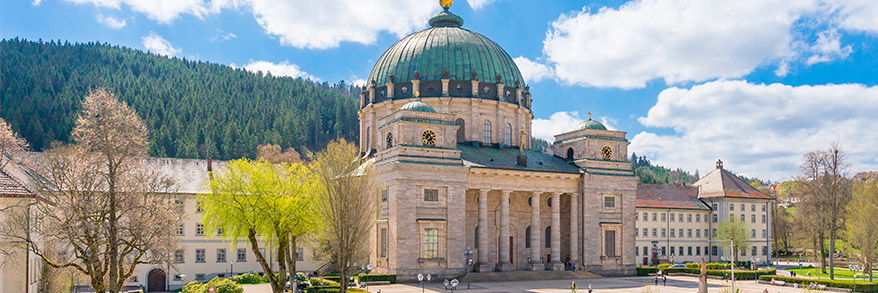The Building
In 1781 first Mass celebrated in the Dome.
In sensationally short construction time the monastery and the church were rebuilt.
On 8 November 1781 Prince Abbot Martin Gerbert provisionally consecrated the new church. Three days later, on 11 November, the name day of the prince abbot, the first solemn Mass could be celebrated in the Dome. The new dome church building had advanced sufficiently so far that the makeshift church outside the monastery could be left and from now on every day Mass could be celebrated in the new room. The actual consecration of the church was only two years later, in September 1783.

The builders really accomplished a sensational performance. Not only the bold dome construction attracted admirers as well as critics from all over at that time, but also the construction time outshone everything that was possible by then.
On 23 July 1768, the church and the monastery fell prey to the fire. Prince Abbot Martin Gerbert had to relocate his friars to other premises and monasteries. Martin Gerbert asked ​​the convent community whether it should ever be rebuilt or whether it would be better to totally move the monastery to Bonndorf.
On 13 December 1768 there was a general conference which advocated the reconstruction of the old place and during which Martin Gerbert was also already able to present the French Michele d'Ixnard's plans of the dome church. First, however, it came down to reconstruct the monastery, here also d'Ixnard worked as an architect. In the autumn of 1772 the Prince Abbot was able to summon back all the scattered friars into their own home.
Only then the building of the church started. The site was filled with fire debris so that the foundation of the new house of God moved 1.20 meters above the natural terrain. Then they began to build the perimeter walls. It was a difficult undertaking to transport the heavy sandstone blocks from far away to the valley. The stones for the reconstruction, especially of the west front, came from the region of Fützen and Ewattingen, the stones of the dome building came from quarries near Ober- and Unteralpfen, near the “Stieg”.
In any case, difficult transport with teams of horses and oxen were necessary. The stones were pulled up from Alpfen via the specially constructed stone path through the “Stiegwald”, first uphill, then again downhill, on especially designed wooden tracks to Niedermühle and finally Albtal, into the building site. The stones from Fützen / Ewattingen came via the Eisenbreche to St. Blasien, the current routing and drivable configuration of the road from Häusern to Seebrugg was only completed later.
Work on the building site was often suspended because of the long winters. It is reported from the year 1775 that the masons and stonecutters only appeared on the site on 30 April, a year later, 40 stonecutters were already able to start working on 23 February. A lot of farmers from all over the area were also employed, which meant a welcome revenue for all, especially in these years because of poor harvests there was often starvation. Prince Abbot Martin Gerbert said then that in these difficult times he could give his peasants no better charity than enough work.
In 1774, the Prince Abbot fell out with the architect d'Ixnard and its construction manager Franz Salzmann. It was now again another Frenchman, Nicholas de Pigage, who called the shots on site and brought in new ideas and changes to the d 'Ixnard plan. From 1776 the raising of the dome could already be started, a masterpiece of the local master carpenter Joseph Muller, who had learned the craft from his father who had never left St. Blasien.
Many craftsmen and artists had the opportunity to work at the church, until, on 8 November 1781, at the two altars of the Rotunda, the first Masses were said by the Prince Abbot and his Father Kellermeister and the first rosary prayed by the people.
In 1783 the abbey church with the fourth-largest church dome in Europe (largest church dome north of the Alps) was inaugurated.
Not even 100 years later, in 1874, the Dome fell victim of another "fire of the century". After the reconstruction, the Dome could be inaugurated again in 1913. For the 200-year anniversary (1983), the church was extensively renovated: The 20 free-standing pillars got a white stucco marble cover, the previously dark pews were replaced by white pews and the floor was laid - according to the original plans of the architect Pierre Michel d'Ixnard - with Carrara marble slabs. Now, the Blasius Dome is a bright, light-filled rotunda.
On top of the church dome, 36 meters in diameter, visible from afar, radiates the golden "orb" with the cross (the monastery was an imperial abbey). The total height is 63 meters.
Services
Dom St. Blasien:
Saturday: 7.00 pm
Sunday: 10.00 am
Sunday: 11.15 am*
* in addition during school hours
Opening hours of the dome
Winter time:
From 8:30 a.m. to 5 p.m.
Summer time:
From 8 a.m. to 6:30 p.m.
During church services or other events the Dome is not open for tourists!

